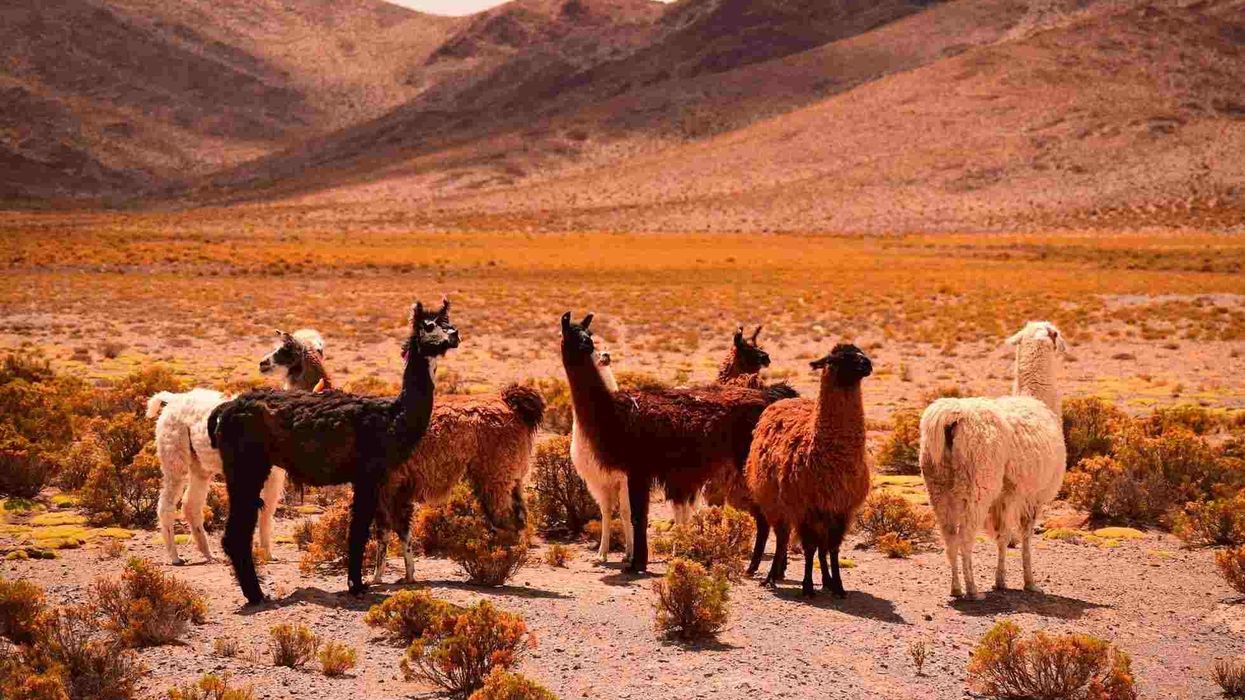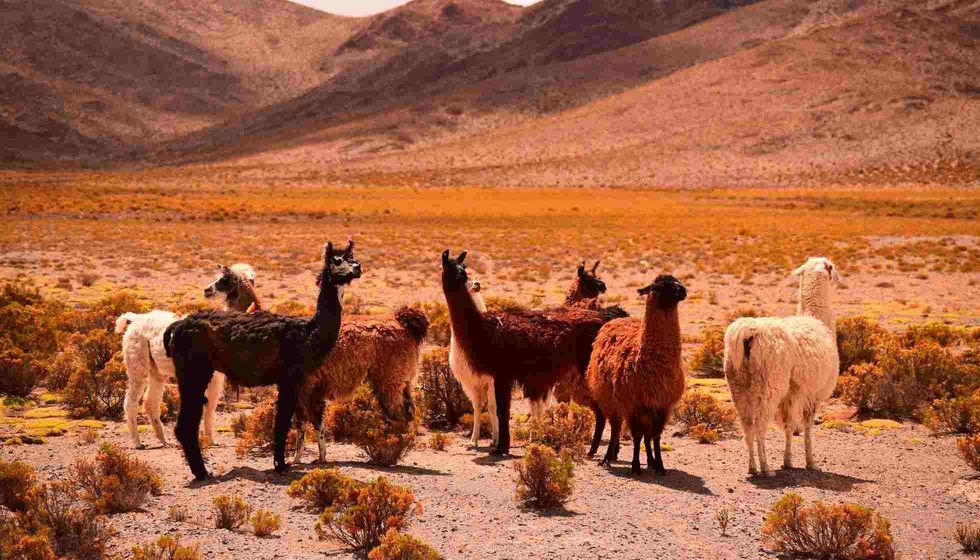Llamas are widely known animals. The word 'llama' is Spanish which literally means 'call' or 'flame'. However, in English 'llama' refers to an animal which is a descendant of the family of camels.
The term 'llama' can also be used as a slang word which indicates 'something stupid'. However, llamas are in fact quite smart and quirky. As a result they can be easily domesticated.
Another characteristic of llamas is that they are quite stubborn in nature. When their patience is being tested, they will just lie on the ground and refuse to move.
This makes them quite cute as creatures in a way. Llama babies, which are called crias, are also extremely adorable. The coat of llamas can be black, grey, white, piebald, or brown in color.
Speaking of their appearance, they bear a striking resemblance to alpacas. Keep reading, to learn more fun facts about this animal. You can also check out Victorian bulldog and Bichon Frise.
Llama Interesting Facts
What type of animal is a llama?
Llamas are a part of the South American camelids. They come from the family of camels.
What class of animal does llama belong to?
Llamas belong to the class Mammalia.
How many llamas are there in the world?
A record of the population of llamas is kept by the International Llama Registry, Montana. This is for the purpose of breeders. Although there is no concrete data on the exact number of llamas that exist at present, the population is estimated to be around eight million by scientists. Most of these llamas reside in South America.
Where does a llama live?
Llamas are known to live in highlands. Interestingly, they cannot reside in forests or in the wild. Llamas can be seen throughout the stretch of the Andes mountains.
Llamas are also kept by Indians residing in Peru, Argentina, Chile, and Bolivia. Although llamas are native to South America, they can be found in Europe, Australia, and North America as well. Llamas were introduced to these places for commercial purposes.
What is a llama's habitat?
Llamas can live in places up to a height of 13123 ft (4000 m) above sea-level. Among highlands, llamas inhabit the Altipano in particular, which is found in the western part of Bolivia and southeastern part of Peru.
While the southern part of the Altipano is quite difficult to reside in, the northern mountainous region has a temperate climate. The habitat of llamas includes plateaus which are covered in grass, shrubs, or other short trees and plants.
Who does a llama live with?
Llamas are very friendly and social animals. As a result, they live in a pack. The collective group of llamas is called a herd. They are pack animals.
How long does a llama live?
The average lifespan of llamas is two decades when they are living in the wild. On the other hand, in captivity they can live up to 15 to 25 years.
In captivity, the longest living llama lived to be 26 years and 258 days old. The llama was named 'Rapper' or 'Ramadan's Arapahoe Gold'. Rapper was owned by two US residents, Jodie McDonie and Brian Kienenberger.
How do they reproduce?
Llamas have a very unique reproductive system. Female llamas have a system of induced ovulation.
It means that it is only when the time for mating arrives that a female llama ovulates. Meaning, an external stimulus facilitates ovulation. They do not go through heat.
Female llamas then produce an egg which gets fertilized. This being said, it is vital to note that while female llamas hit puberty at one year of age, male llamas do not attain maturity until the age of three. After fertilization, the gestation period continues for about 350 days which is almost a year.
Female llamas give birth to a single newborn in a standing position. This generally takes place between eight in the morning and noon as the warm temperature and light of these hours is suitable to give birth to a healthy fetus.
What is their conservation status?
According to the International Union for Conservation of Nature (IUCN) Red List, their conservation status as Least Concern. The number of llamas in the world is believed to be stable. They are a species which is not threatened by extinction as of now.
Llama Fun Facts
What does a llama look like?
A llama has a long neck and long limbs which gives a distinct appearance to the animal. They look very similar to alpacas and resemble the facial structure of camels. They have a short and fluffy tail. Their coats are thick and made of wool.
The heavy coat is due to their mountainous habitats. Another factor which they have because they live in cold climates is a high concentration of hemoglobin in their blood. This helps them to survive at high altitudes and adapt to their environments.
How cute are they?
Llamas are quite cute to look at. They have a thick furry coat which gives them a fuzzy appearance. Their facial features and long neck also add to their cuteness. They are quirky and curious, social animals which make llamas quite adorable.
How do they communicate?
Llamas communicate largely through sound, smell, and touch. They emit sounds when they feel endangered and also to make others of their kind wary of a possible nearby predator or source of harm. Llamas defecate in piles to mark their territory.
When other llamas see or smell this pile of feces, they are aware that it is another's region. On the other hand, female llamas communicate with their young ones through touch.
Touch is also a vital way of communication between two rival male llamas. Llamas use different positions or body gestures to communicate. This is clear from the fact that there exists a submissive position among these animals.
How big is a llama?
The llama stands 67-71 in (170-180 cm) tall. On the other hand, llamas can be 36-63 in (92–160 cm) long. It is approximately the same size as a goat.
How fast can a llama run?
Llamas can run at a speed of up to 40 mph (64 kph).
How much does a llama weigh?
Llamas (Lama glama) have a weight of around 287-441 lb (130–200 kg).
What are their male and female names of the species?
Male llamas are called 'studs'. On the other hand, castrated male llamas are called 'geldings'. Meanwhile, female llamas, who are mothers, are called 'dams'. In Spanish, all female llamas are called 'hembras'.
What would you call a baby llama?
Baby llamas are called 'crias' until they are six months old. After that, a young llama is called a 'tuis'.
What do they eat?
These animals are herbivores and a llama feeds on vegetation that grows on mountainous or hilly areas like lichens, shrubs, and grass. Since these animals reside in highlands where the climate is dry, they tend to retain moisture from what they eat.
These animals are known to eat a little less than 2% of their body weight of dry food, while they drink 2 to 3 gallons (7.5-11 l) of water per day. These animals have three stomachs.
Like cows they are ruminants. This means that they ferment their food in one of their stomachs before digesting it.
This process occurs through the presence of special microbes. As a result of this process, which is also called chewing the cud, these animals can bring back the swallowed food into their mouth to chew it again and digest it.
Are they dangerous?
Although these animals are not always dangerous, they can cause harm when they feel threatened. They rarely cause harm to humans. Most of their fights are with other animals of their kind, whether it be in the wild or within their herd.
Would they make a good pet?
Llamas, which are native to South America, are making their way into people's hearts as a well-known pet, especially in mountainous areas. They are docile in nature. They are clean and friendly too. These pack animals are also good as guard animals. Apart from that, these guard animals are low maintenance, and show stable health conditions.
Did you know...
Llamas are prey and not generally predators.
Llamas are known for their wool, which is made into rugs, ropes, and clothes. Their feces is burnt for fuel as well. They can carry a weight of 80-100 lb (36-45 kg) for a stretch of 5-8 miles (8-13 km). Hence, they are quite important as farm animals.
Although llamas and alpacas are closely related, they are different species and differ mainly in facial features, body hair, and size. The wool of alpacas can produce more fleece, while the wool of llamas is rougher than that of alpacas.
Another difference between llamas and alpacas also lie in their ears. An alpaca does not have long ears in the shape of bananas like the ears of a llama. Llamas are said to be better as they guard other animals.
Llamas are also nicer than alpacas since they are friendlier. However, both of them are found in countries like Bolivia and Peru, and they belong to the same family of camels.
The word 'llama' is correctly pronounced as 'yama'.
The most common predators of a llama include pumas, coyotes, and humans.
Llamas can jump quite a considerable height. The record for the highest jump has been set by Caspa who jumped 3 ft 8 in (1.13 m) high.
Llamas and sheep are not related despite the similarity in their wool.
Do llamas spit?
Yes, llamas do spit. They can spit from a distance of 10-15 ft (3-4.5 m). Spitting is usually used as a defense against danger or irritability.
Llamas spit to keep away predators or other aggressors. Females spit on a male to show signs of disinterest. Meanwhile, both males and females spit to safeguard their food from others within their herd or even animals outside their herd.
Where does the llama originate from?
Llamas originate from South America. They were bred in the wild and then in captivity across civilizations. However, their ancestors are said to have originated about 40 million years ago from North America's central plains. They have a history of being domesticated since 9000 years ago.
Here at Kidadl, we have carefully created lots of interesting family-friendly animal facts for everyone to discover! Learn more about some other mammals including the zonkey, or the klipspringer.
You can even occupy yourself at home by drawing one on our antelope coloring pages.










